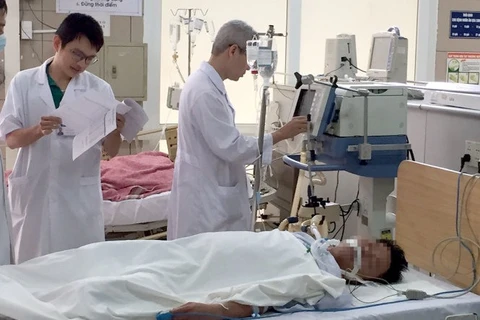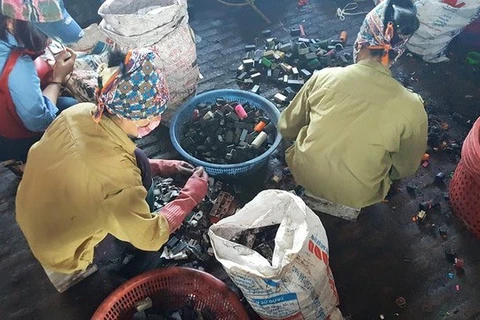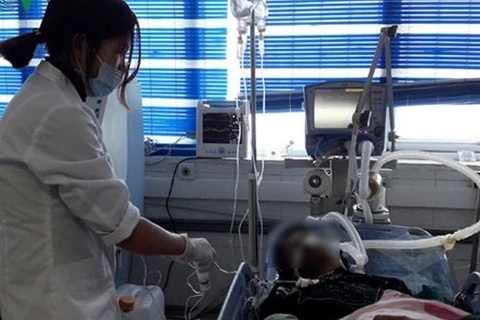Hanoi (VNA) - Doctors from Bach Mai Hospital in Hanoi have reported at least one patient everyday hospitalised due to herbicide poisoning, popularly known as paraquat poisoning.
The fatality rate after ingesting just 5ml of the chemical is 90 percent, doctors said.
Every year, about 1,000 people die of paraquat poisoning across the country.
Nguyen Trung Nguyen, head of the Poison Control Centre of Bach Mai Hospital, said the number of paraquat poisoning cases in 2015 at Bach Mai Hospital was 300, with the figure rising to 500 last year.
Most patients drank the chemical to commit suicide, Nguyen said.
The herbicide is quick-acting and non-selective, killing green plant tissue on contact.
He said patients can only be saved if poisoned by small doses of up to three millilitres.
But treatment is expensive, requiring blood filtration sessions costing up to 100 million VND (4,400 USD), and the chances of survival are still slim, he said.
“Many people regret taking the herbicide after being hospitalised and receiving treatment. But what’s painful about this is that there’s no way they can go back – because most of them die,” he said.
“Most of them will die within three days to three months, however intensively they are treated. Paraquat is absorbed quickly, within two to six hours, and it caused severe damage to the heart, lungs and liver,” Nguyen said.
Patients may feel better after receiving treatment, but are dying inside because of tissue that has been damaged.
“Dying because of paraquat poisoning is scarier than other ways as the patients are awake and conscious until they die,” Nguyen said.
Paraquat, a chemical weed killer, and 2,4-D, an organic compound, are used to control a broad range of weeds, but leave cereals, lawn turf, and grasslands relatively unaffected.
2,4-D paraquat can be found in many commercial lawn herbicide mixtures, and is widely used as a weed killer for cereal crops, pastures, and orchards. More than 1,500 herbicide products contain 2,4-D as an active ingredient.
Breathing in Paraquat can cause lung damage and lead to a disease called Paraquat lung. Paraquat damages the body when it touches the lining of the mouth, stomach, or intestines.
Long-term exposure to Paraquat may cause scarring of the lungs called pulmonary fibrosis.
On February 8, the Ministry of Agriculture and Rural Development issued a decree prohibiting the use of plant protection products containing paraquat and 2,4-Dichlorophenoxyacetic acid (2,4-D) in Vietnam, after years of scientists repeatedly warning about its danger.
The ministry still allows the trade and use of the products for two years starting from when the ban became effective.
“We made the transition time two years so that enterprises can gradually eliminate these products,” said Hoang Trung, head of the Plant Protection Department under the Ministry of Agriculture and Rural Development.
Regarding this, doctor Nguyen from Bach Mai Hospital said he wonders if the buffer time is necessary.
“The sooner we ban this herbicide, the more people we can be saved,” he said.-VNA
The fatality rate after ingesting just 5ml of the chemical is 90 percent, doctors said.
Every year, about 1,000 people die of paraquat poisoning across the country.
Nguyen Trung Nguyen, head of the Poison Control Centre of Bach Mai Hospital, said the number of paraquat poisoning cases in 2015 at Bach Mai Hospital was 300, with the figure rising to 500 last year.
Most patients drank the chemical to commit suicide, Nguyen said.
The herbicide is quick-acting and non-selective, killing green plant tissue on contact.
He said patients can only be saved if poisoned by small doses of up to three millilitres.
But treatment is expensive, requiring blood filtration sessions costing up to 100 million VND (4,400 USD), and the chances of survival are still slim, he said.
“Many people regret taking the herbicide after being hospitalised and receiving treatment. But what’s painful about this is that there’s no way they can go back – because most of them die,” he said.
“Most of them will die within three days to three months, however intensively they are treated. Paraquat is absorbed quickly, within two to six hours, and it caused severe damage to the heart, lungs and liver,” Nguyen said.
Patients may feel better after receiving treatment, but are dying inside because of tissue that has been damaged.
“Dying because of paraquat poisoning is scarier than other ways as the patients are awake and conscious until they die,” Nguyen said.
Paraquat, a chemical weed killer, and 2,4-D, an organic compound, are used to control a broad range of weeds, but leave cereals, lawn turf, and grasslands relatively unaffected.
2,4-D paraquat can be found in many commercial lawn herbicide mixtures, and is widely used as a weed killer for cereal crops, pastures, and orchards. More than 1,500 herbicide products contain 2,4-D as an active ingredient.
Breathing in Paraquat can cause lung damage and lead to a disease called Paraquat lung. Paraquat damages the body when it touches the lining of the mouth, stomach, or intestines.
Long-term exposure to Paraquat may cause scarring of the lungs called pulmonary fibrosis.
On February 8, the Ministry of Agriculture and Rural Development issued a decree prohibiting the use of plant protection products containing paraquat and 2,4-Dichlorophenoxyacetic acid (2,4-D) in Vietnam, after years of scientists repeatedly warning about its danger.
The ministry still allows the trade and use of the products for two years starting from when the ban became effective.
“We made the transition time two years so that enterprises can gradually eliminate these products,” said Hoang Trung, head of the Plant Protection Department under the Ministry of Agriculture and Rural Development.
Regarding this, doctor Nguyen from Bach Mai Hospital said he wonders if the buffer time is necessary.
“The sooner we ban this herbicide, the more people we can be saved,” he said.-VNA
VNA
























